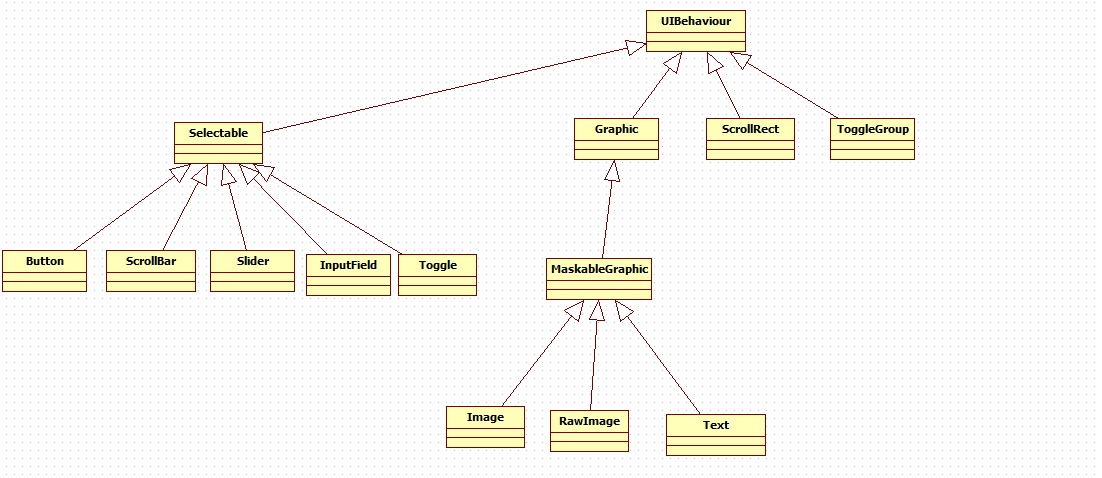Unity UGUI鼠标穿透UI问题
简述
最近在用UGUI的时候遇到了鼠标穿透的问题,就是说在UGUI和3D场景混合的情况下,点击UI区域同时也会 触发3D中物体的鼠标事件。比如下图中

这里给Cube加了一个鼠标点击改变颜色的代码,如下
void Update() { if(Input.GetMouseButtonDown(0)) { GetComponent<Renderer>().material.color = new Color(Random.value, Random.value, Random.value, 1.0f); } }
运行一下,会发现只要有鼠标点击(任何位置点击),Cube的颜色就会改变,根据代码我们知道这也是必然的,但是问题是如果Cube是一个3D世界中的mesh或者terrain,而button是UI的话也同样会出现同样的问题。
在游戏开发中我们的UI是始终出现在屏幕的,如果在一个战斗场景中用户点了UI战斗场景中的物体也会作出响应肯定是有问题的!
其实关于这个问题网上有不少解决方法了,但是总感觉没有一个是适合我的需求,或者说没有一个最好的答案。
其中提到最多的是利用EventSystem.current.IsPointerOverGameObject()来判断,这个方法的意义是判断鼠标是否点到了GameObject上面,这个GameObject包括UI也包括3D世界中的任何物体,所以他只能判断用户是都点到了东西。对于本文中的问题意义不是很大。那么这个问题到底该怎么解决呢?
原理
解决方法最终还是离不开射线检测,不过UGUI中已经封装了针对UI部分的射线碰撞的功能,那就是GraphicRaycaster类。里面有个Raycast方法如下,最终就是将射线碰撞到的点添加进resultAppendList数组。
public override void Raycast(PointerEventData eventData, List<RaycastResult> resultAppendList) { if (canvas == null) return; // Convert to view space Vector2 pos; if (eventCamera == null) pos = new Vector2(eventData.position.x / Screen.width, eventData.position.y / Screen.height); else pos = eventCamera.ScreenToViewportPoint(eventData.position); // If it's outside the camera's viewport, do nothing if (pos.x < 0f || pos.x > 1f || pos.y < 0f || pos.y > 1f) return; float hitDistance = float.MaxValue; Ray ray = new Ray(); if (eventCamera != null) ray = eventCamera.ScreenPointToRay(eventData.position); if (canvas.renderMode != RenderMode.ScreenSpaceOverlay && blockingObjects != BlockingObjects.None) { float dist = eventCamera.farClipPlane - eventCamera.nearClipPlane; if (blockingObjects == BlockingObjects.ThreeD || blockingObjects == BlockingObjects.All) { RaycastHit hit; if (Physics.Raycast(ray, out hit, dist, m_BlockingMask)) { hitDistance = hit.distance; } } if (blockingObjects == BlockingObjects.TwoD || blockingObjects == BlockingObjects.All) { RaycastHit2D hit = Physics2D.Raycast(ray.origin, ray.direction, dist, m_BlockingMask); if (hit.collider != null) { hitDistance = hit.fraction * dist; } } } m_RaycastResults.Clear(); Raycast(canvas, eventCamera, eventData.position, m_RaycastResults); for (var index = 0; index < m_RaycastResults.Count; index++) { var go = m_RaycastResults[index].gameObject; bool appendGraphic = true; if (ignoreReversedGraphics) { if (eventCamera == null) { // If we dont have a camera we know that we should always be facing forward var dir = go.transform.rotation * Vector3.forward; appendGraphic = Vector3.Dot(Vector3.forward, dir) > 0; } else { // If we have a camera compare the direction against the cameras forward. var cameraFoward = eventCamera.transform.rotation * Vector3.forward; var dir = go.transform.rotation * Vector3.forward; appendGraphic = Vector3.Dot(cameraFoward, dir) > 0; } } if (appendGraphic) { float distance = 0; if (eventCamera == null || canvas.renderMode == RenderMode.ScreenSpaceOverlay) distance = 0; else { // http://geomalgorithms.com/a06-_intersect-2.html distance = (Vector3.Dot(go.transform.forward, go.transform.position - ray.origin) / Vector3.Dot(go.transform.forward, ray.direction)); // Check to see if the go is behind the camera. if (distance < 0) continue; } if (distance >= hitDistance) continue; var castResult = new RaycastResult { gameObject = go, module = this, distance = distance, index = resultAppendList.Count, depth = m_RaycastResults[index].depth, sortingLayer = canvas.sortingLayerID, sortingOrder = canvas.sortingOrder }; resultAppendList.Add(castResult); } } }
从这个方法开始深入查看Unity UGUI源码你会发现,其实每个组件在创建的时候已经被添加进了一个公共列表,UGUI 源码中的GraphicRegistry类就是专门干这件事的。再看下Graphic类中的OnEnable方法
protected override void OnEnable() { base.OnEnable(); CacheCanvas(); GraphicRegistry.RegisterGraphicForCanvas(canvas, this); #if UNITY_EDITOR GraphicRebuildTracker.TrackGraphic(this); #endif if (s_WhiteTexture == null) s_WhiteTexture = Texture2D.whiteTexture; SetAllDirty(); SendGraphicEnabledDisabled(); }
看这句GraphicRegistry.RegisterGraphicForCanvas(canvas, this);就是注册需要做射线检测的UI组件。再看他内部是如何工作的
public static void RegisterGraphicForCanvas(Canvas c, Graphic graphic) { if (c == null) return; IndexedSet<Graphic> graphics; instance.m_Graphics.TryGetValue(c, out graphics); if (graphics != null) { graphics.Add(graphic); return; } graphics = new IndexedSet<Graphic>(); graphics.Add(graphic); instance.m_Graphics.Add(c, graphics); }
不过,问题又来了,为什么是添加进列表的对象都是Graphic类型呢?这跟ScrollRect,Button,Slider这些有关吗?其实,这就跟UGUI的类继承关系有关了,其实我们使用的UGUI中的每个组件都是继承自Graphic或者依赖一个继承自Graphic的组件
看一下UGUI的类层次结构就会一目了然,如下

看图就会更加清楚,在这我们可以把我们用到的UGUI的所有组件分为两类,1.是直接继承自Graphic的组件。2.是依赖于1的组件"[RequireComponent(typeof(Griphic))]",仔细想想会发现,所有组件都属于这两种中的某一种。
所以对所有Graphic进行Raycast其实就相当于对所有UI组件进行Raycast。
结合上面的知识所以,解决这个问题最好的方法是根据,UGUI的射线碰撞来做。这样会比较合理。
解决方案
这里我们直接在使用Input.GetMouseButtonDown(0)的地方加了一个检测函数,CheckGuiRaycastObjects,如下
bool CheckGuiRaycastObjects() { PointerEventData eventData = new PointerEventData(Main.Instance.eventSystem); eventData.pressPosition = Input.mousePosition; eventData.position = Input.mousePosition; List<RaycastResult> list = new List<RaycastResult>(); Main.Instance.graphicRaycaster.Raycast(eventData, list); //Debug.Log(list.Count); return list.Count > 0; }
不过在使用时需要先获取两个加粗显示的变量,graphicRaycaster和eventSystem。
这两个变量分别对应的是Canvas中的GraphicRaycaster组件,和创建UI时自动生成的“EventSystem”中的EventSystem组件,用的是自己制定以下就可以。
然后在使用的时候可以这样:
void Update () { if (CheckGuiRaycastObjects()) return; //Debug.Log(EventSystem.current.gameObject.name); if (Input.GetMouseButtonDown(0)) { Ray ray = Camera.main.ScreenPointToRay(Input.mousePosition); RaycastHit hit; if (Physics.Raycast(ray, out hit)) { //do some thing } } }
还有一个需要注意的地方就是,在做UI的时候一般会用一个Panel做跟目录,这个panel也会被添加到GraphicRegistry中的公共列表中,如果是这样的话记得把list.Count>0改成list.Count>1,或者直接删除Panel上的继承自Graphic的组件。
这样在结合着EventSystem.current.IsPointerOverGameObject()来使用就比较好了。
